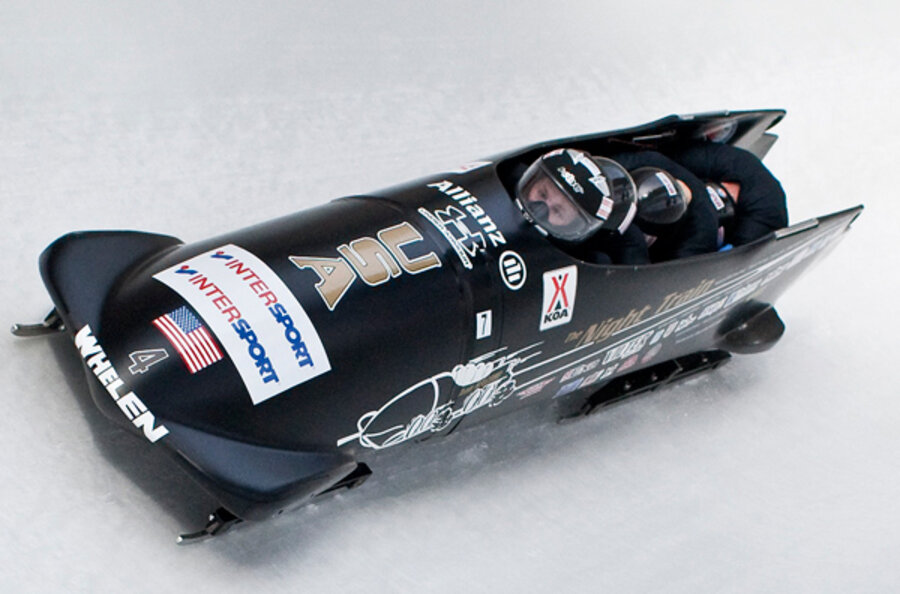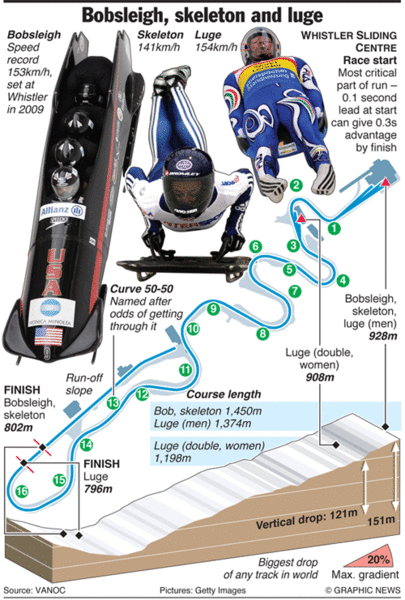Vancouver 2010 Olympic Games: Bobsled
Loading...
The record-fast Whistler track may favor the talented German team, but look for strong performances from the Americans and the Canadian women, who have two sleds ranked among the top five internationally.
Who to watch
Steve Holcomb, USA (see video)
Ranked No. 1 in the world in the four-man, Holcomb made history in 2009 by piloting the first US victory in the four-man World Championships in 50 years. It's been 62 years since the American men won Olympic gold in the event – a drought Holcomb is no doubt looking to break after winning silver at the test Olympic event in Whistler last season. His sled, dubbed the Night Train, has an aura of mystery - not least of all because it was never properly painted, so eager was Holcomb to ship it out to his next World Cup event when it was first finished.
Sandra Kiriasis, GER (see video)
Kiriasis is hands-down the most dominant female bobsledder on the international circuit. She has won eight straight overall World Cup titles, awarded based on cumulative points from a full season of competitions at the highest level. She is both the defending Olympic gold medalist and the reigning world champion. A transplant from luge, the German first took a bobsled run in 2000; two years later, she won silver at the Salk Lake City Olympic games. Kiriasis stands 6’0” and is known for her intensely competitive nature.
Curt Tomasevicz USA
The former linebacker from Nebraska’s cornfields never dreamed of roaring down an icy track. But after training with a women’s bobsled Olympic hopeful to stay in shape, he took up the sport. Now a star member of the US team, he’s won numerous World Cup medals already this season.
Other Americans to watch: The US is sending three men's four-man teams and two women's teams. Among the most accomplished athletes is Shauna Rohbock (see video), who piloted her sled to the sole US bobsledding medal in the 2006 Games. A former All-American soccer player and heptathlete, Rohbock played two seasons for the San Diego Spirit women’s national soccer team. Recruited to the US bobsled team after final collegiate track season, Rohbock wears silver medals from the 2009 World Championships and 2006 Torino Games. Also strong is the team of Elana Meyers and Eric Pac, as well as John Napier's four-man sled.
Event Details
Click here for schedule and results.
All three Olympic bobsled events hold four heats each over two days, with medals being awarded to the team with the lowest combined time, measured to 1/100ths of a second. Each sled has a driver and a brakeman, with the four-man teams having two extra push athletes to help at the start. The athletes, many of whom come from a track and field or football background, use spiked shoes to generate as much speed as possible in the 50-meter start zone before jumping into the sled.
In a four-man, the driver gets in first, then the second man jumps off the ice followed by the third man. Both must wait until the fourth is settled before they can sit down. With practice, the complicated maneuver happens nearly simultaneously. The larger sled, which can weigh nearly 1,400 pounds when loaded, has been compared to a Greyhound bus by US driver Steve Holcomb, who contrasted it with the Ferrari-like two-man sled.
The three bobsled events are:
- Two-Man (see Team Switzerland at FIS World Championship Two Man Bobsled)
- Four-Man (see How they train)
- Two-Woman (see Cathleen Martini of Germany takes second in the World Cup)
History
For wealthy 19th-century Europeans who were looking for the rush of fast mountain descents but didn’t want to do so standing up, like alpine skiers, bobsledding was their answer. The first bobsled was designed in 1886, and was not much more than a toboggan with a steering mechanism attached. Soon, the wooden sleds were upgraded to steel and came to be known as bobsleds because of the way crews bobbed back and forth to increase their speed on the straightaways.
Today’s bobsled has traveled a long way from the original Swiss concept. Snowy mountain roads have been replaced by ice-covered concrete tracks and the sleds have been upgraded to aerodynamic fiberglass bullets. In the US, they are designed by some of the same engineers who work on NASCAR technology. Today’s top bobsled teams reach speeds of more than 90 m.p.h. and can pull 5Gs while careening around banked corners.
The four-man bobsled was included in the first Olympic Winter Games in 1924 and the two-man event followed eight years later. The women’s bobsled was added to the Olympic program in 2002 as part of a push spearheaded by Salt Lake City mayor Deborah Corradini to include more women's events.
Sources: International Federation of Bobsleigh and Tobogganing (FIBT), www.sandra-kiriasis.de, vancouver2010.com, nbcolympics.com, universalsports.com






